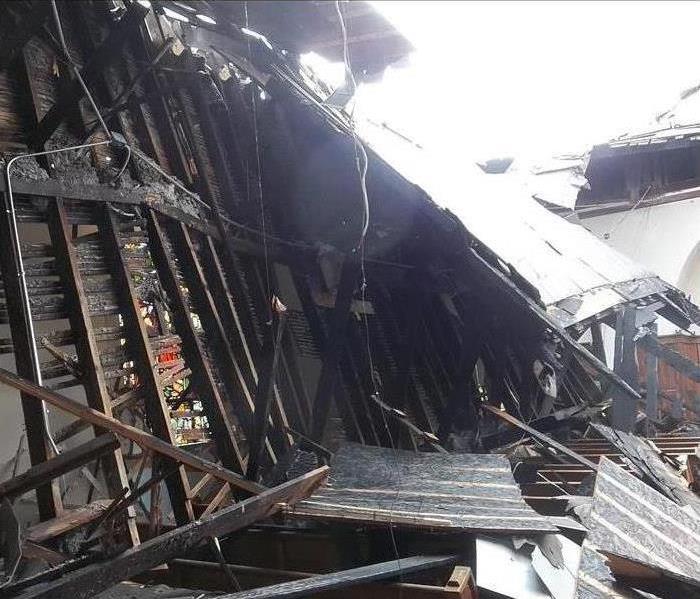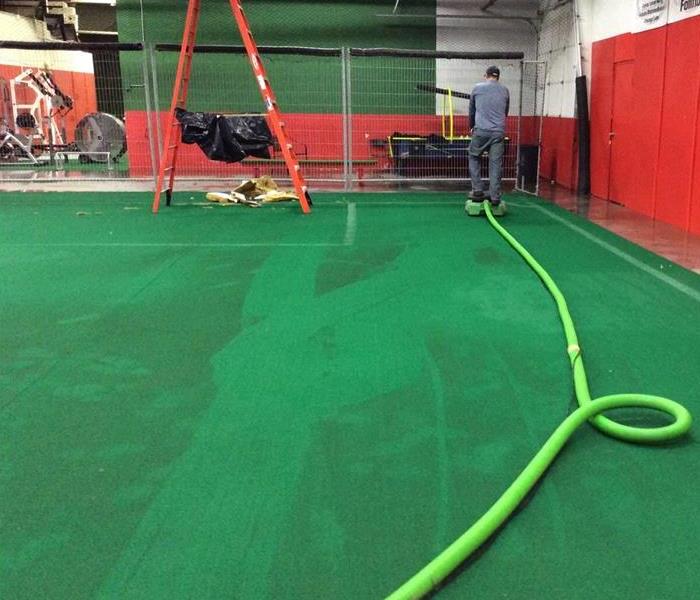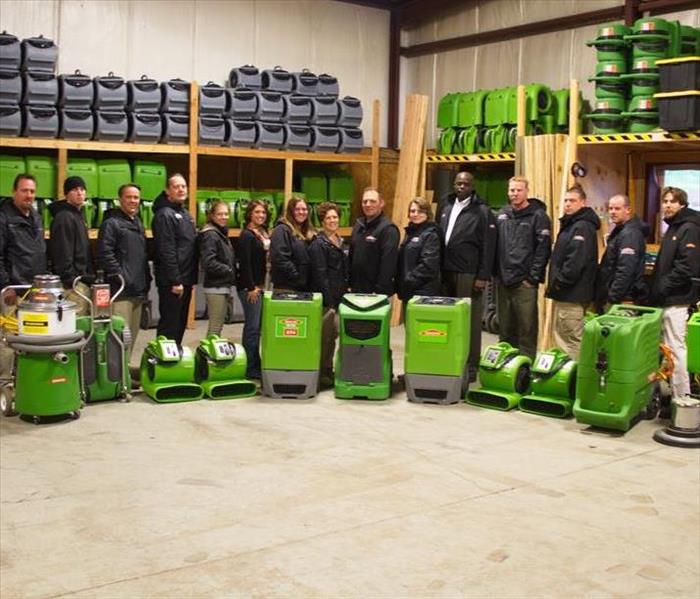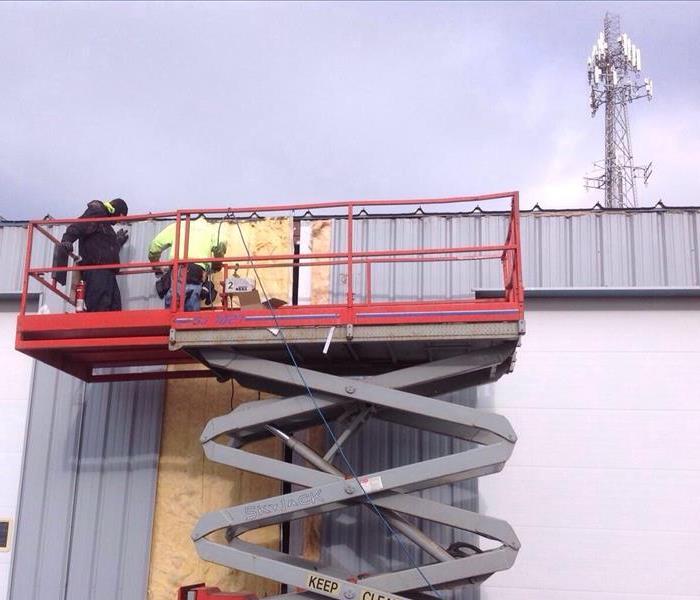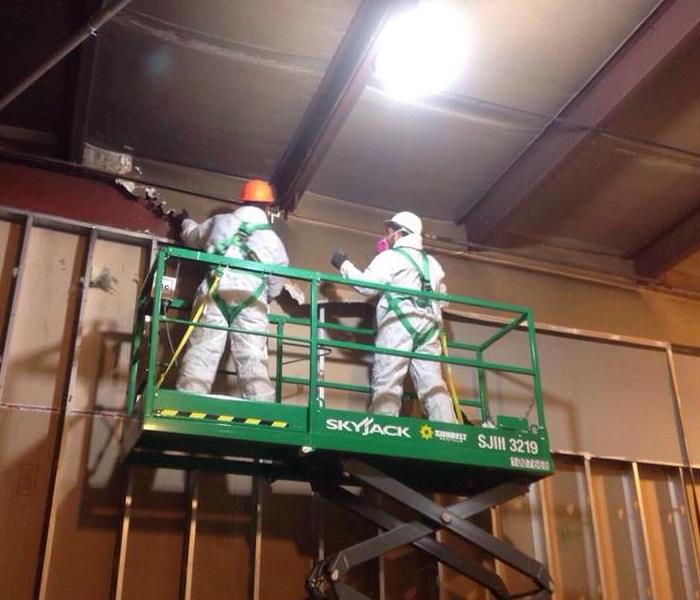Archived Commercial Blog Posts
What Causes Commercial Fires?
10/29/2024 (Permalink)
Business owners and employees must be on guard for these common causes of workplace fires, according to the NFPA:
- Cooking appliances and equipment. Cooking equipment remain as the leading cause of commercial fires, according to the NFPA. To prevent cooking fires, never leave appliances unattended, perform routine maintenance of kitchen and cooking equipment, and install sprinklers and smoke alarms.
- Electrical distribution and lighting equipment. Frayed or damaged wiring and malfunctioning lighting equipment should be repaired or replaced by a licensed technician immediately.
- Office or electronic equipment. Use electronic equipment correctly and never utilize defective or damaged electronic devices. Also, avoid overloading adapters and remove combustible materials near electronics.
- Heating equipment. Heating fire deaths are most often caused by placing the heating equipment close to flammable materials, such as bedding, mattresses or upholstery.
- Arson or intentional fires. This type of fire causes the most damage to commercial property and life. To prevent intentional fires, empty trash bins and dumpsters every day. Installing motion detector cameras can also help.
- Smoking materials. Create a smoking policy for your workplace, such as smoking outside and using ashtrays, to prevent the risk of fire.
- Exposure fires. If a fire is not contained, it could spread to other materials in its immediate surroundings and cause exposure fire. Protect objects from the heat spread to prevent them from igniting.
Fire Loss in Commercial Buildings
10/11/2024 (Permalink)
Fire, smoke, and soot can affect anything in your business or home, from the structure to personal belongings. After a fire, contacting a cleaning professional may be the best decision you can make.
Smoke and soot facts:
- Hot smoke migrates to cooler areas and upper levels of a structure.
- Smoke flows around plumbing systems, seeping through the holes used by pipes to go from floor to floor.
- The type of smoke may greatly affect the restoration process.
Different Types of Smoke:
There are two different types of smoke–wet and dry. As a result, there are different types of soot residue after a fire.
- Wet Smoke – Plastic and Rubber
- Low heat, smoldering, pungent odor, sticky, smeary. Smoke webs can be more difficult to clean.
Dry Smoke – Paper and Wood - Fast burning, high temperatures, heat rises therefore smoke rises.
- Protein Fire Residue – Produced by evaporation of material rather than from a fire
Virtually invisible, discolors paints and varnishes, extreme foul odor.
Since each smoke and fire damage situation is a little different, each one requires a unique solution. We have the equipment, expertise, and experience to restore your fire and smoke damage.
Call SERVPRO® of Streamwood/ Bartlett/ West Chicago City
630-562-9212
Risks of Owning a Business in a Floodplain Zone
10/9/2023 (Permalink)
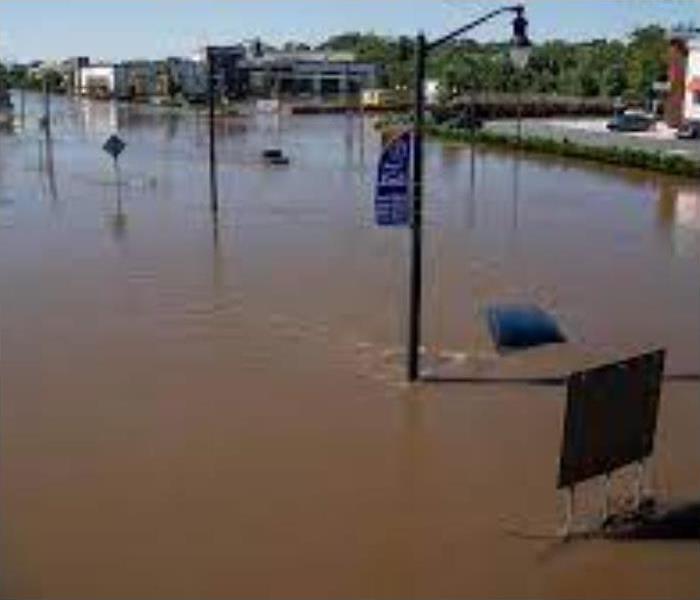 Depending on the location, a floodplain can be a minor component of a landscape or the primary feature.
Depending on the location, a floodplain can be a minor component of a landscape or the primary feature.
Floodplain zones help builders and business owners determine the level of risk associated with building in or inhabiting areas near a waterway (lake, river, stream, creek). Insurance agents use flood maps to identify the zones, which guide them in determining flood insurance requirements and coverage costs.
You can experience a devastating flood event, even if you live in a low-risk zone. Whether you live in a high- or low-risk floodplain zone, purchasing flood insurance is crucial to protect against financial losses resulting from floods, even if not required. Even a couple of inches of water can lead to several thousand or tens of thousands of dollars of damage.
If you choose to have your business in a floodplain zone, there are some important considerations to make:
- Purchase appropriate flood insurance (even if you aren’t required to by law).
- Use flood-resistant building materials in the home, such as laying tile instead of carpet, especially in the basement.
- Install flood vents, which allow the waters to flow through the vents and drain out.
- Elevate your property so the lowest floor is higher than the flood elevation level as identified on the flood map.
- Store belongings that would be adversely affected by water in a high location or a waterproof box to keep them safe from floodwaters.
- Have a plan in place for water damage restoration that you can utilize immediately following a flood event. Addressing water damage right away (within 24-48 hours) minimizes damage and avoids common post-flood problems like mold growth.
Biohazard Cleanup for Hospitality, Commercial, Industrial, and Rental Property Owners
10/7/2022 (Permalink)
 A biohazard is any biological substance that poses a threat to the health of all living organisms
A biohazard is any biological substance that poses a threat to the health of all living organisms
Why SERVPRO for Biohazard Cleanup?
Commercial biohazard clean up is challenging work and should be left to the SERVPRO of Streamwood, Bartlett, West Chicago and Warrenville. However, if you have a biohazard situation at hand, you must get in touch with a biohazard cleaning company as soon as possible. The more you wait, the higher are the chances of you and your employees being exposed to biohazards.
When many businesses come face-to-face with biohazard situations, they try to stage a cover-up by employing amateur cleaning techniques. Unfortunately, this could prove to be a very costly mistake. Not only can employees get exposed to hazardous materials, but the business can also get a bad rap.
Cleanup work requires special training and expertise. Anyone who handles biohazards is at high risk of exposure to hazardous materials. Biohazard cleanup specialists are trained to handle and dispose of biohazards safely.
If someone committed suicide or was murdered at your facility, you are responsible for cleaning or decontaminating the scene. If the crime scene cleanup is not your forte and your employees are not mentally or emotionally equipped to handle crime scene cleanup, you should hire a biohazard cleanup specialist.
A biohazard cleanup specialist is qualified to handle such cleanup and eliminate all sensory reminders of the unfortunate event.
Biohazard Cleanup Process
? Once the expert arrives at your facility, they might seal the area to reduce contamination risks.
? They will put on safety gear and prepare disinfectant.
? Then, using tongs or forceps, the team will remove any sharp objects such as broken glass, metal shards, medical sharps, or razor blades.
? They will then cover the spill area with absorbent material.
? Next, the team will remove the absorbent material, place it in the biohazard bag, and apply an EPA registered disinfectant to the contaminated area.
? The disinfectant should be allowed to sit for a few hours. Using paper towels, the team will then remove disinfectant and place the paper towels in a biohazard bag.
? They will then place the biohazard bag in a biohazardous waste container for treatment and disposal.
Commercial Water Damage Restoration
10/4/2022 (Permalink)
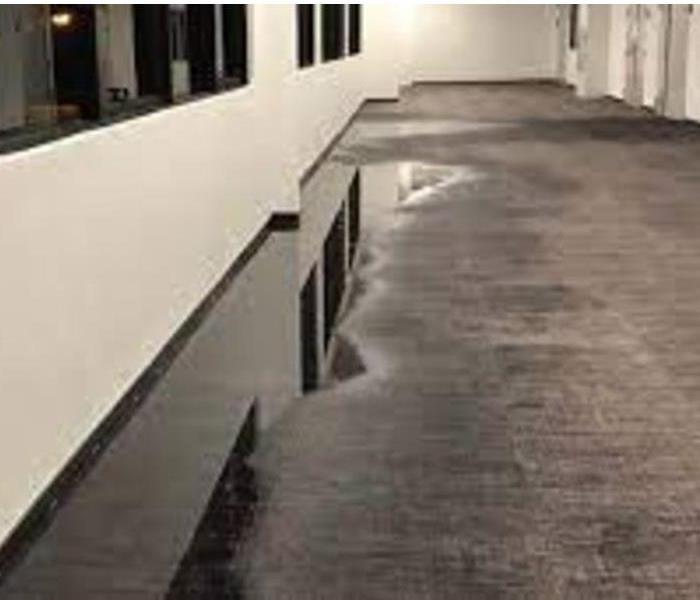 Having a business in a place that constantly experiences flooding and other related issues can be frustrating
Having a business in a place that constantly experiences flooding and other related issues can be frustrating
Commercial Water Damage Restoration
It is impossible to predict when your business premises will be affected by water damage. However, it helps to be prepared while dealing with excess water in your area.
Sometimes, you’re only dealing with small amounts of water on the property. Generally, this can be handled by the cleaning staff. However, when there is an excess amount of water, you need to call in SERVPRO of Streamwood, Bartlett, West Chicago and Warrenville.
It is crucial to act immediately in such situations, as it can minimize any further damage that may occur. For instance, if the water stays in your business property for up to 48 hours, it can start developing mold. This will then become a separate issue that needs to be solved.
When you call SERVPRO of Streamwood, Bartlett, West Chicago and Warrenville, the highly-trained technicians arrive at the site and start working on restoring the water damage immediately. Not only would they have the proper equipment for water damage restoration, but they would also develop a plan according to the severity of the impact on your property.
After removing the water, they will also ensure that your business property is thoroughly dried and sanitized, preventing the chance for any mold to grow. If there is any physical damage to the property, they will try their best to repair it.
So if you’ve been affected by water damage due to excess water on your property, call SERVPRO of Streamwood, Bartlett, West Chicago and Warrenville immediately.
Air Duct Cleaning Improves Air Quality for Your Office
9/20/2022 (Permalink)
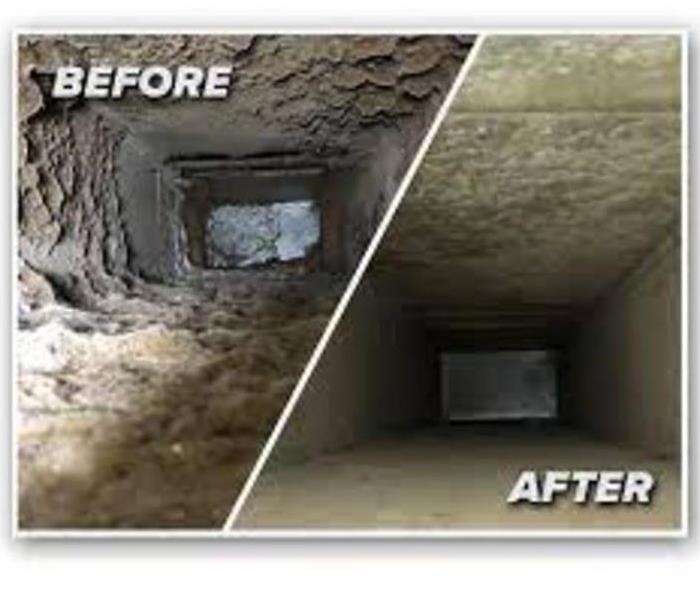 Mold, dust, pollen and other allergens can build up in your HVAC system over time – just like they do on other surfaces in your office.
Mold, dust, pollen and other allergens can build up in your HVAC system over time – just like they do on other surfaces in your office.
How Air Duct Cleaning Improves Air Quality
Except for the air you let into your office through windows or doors, most of the air in your office is distributed via HVAC ductwork. Without a clean path for this air to take, it picks up irritants and contaminants, circulating them through your home. No matter how much you vacuum or dust, they’ll return, piling-up on flat surfaces, and piling onto your list of cleaning duties, all-the-while collecting within your HVAC system, mucking-up your air filter, ductwork and coils. As time progresses, the contaminant buildup worsens, robbing your system of efficiency, and increasing maintenance needs.
(This is why after duct cleaning is performed, it is strongly recommended you let SERVPRO of Streamwood, Bartlett, West Chicago and Warrenville clean dust buildup in your office.)
Importance of Clean Air Ducts
Clean ducts offer a number of benefits…
- Reducing the Incidence of Allergies & Respiratory Ailments
Mold, mildew, dust, dust mites, dirt, pollen, dander and other particles settle in ductwork over time, spreading through the air during HVAC operation. Ductwork cleaning can remove this buildup, reducing the levels of these irritating triggers in the office. - Fighting Mold & Microbial Growth
The buildup of dust on ductwork surfaces offers a prime environment for the proliferation of mold, mildew, dust mites, bacteria and more. Regular duct cleaning reduces contaminant growth. - Decreasing Offensive Odors
Duct cleaning can eliminate or reduce offensive odors due to mold, mildew, and microbial growth, as well as those resulting from pest infestation in ductwork. - Boosting HVAC Efficiency
In cases of extreme dust buildup, cleaning ductwork has been shown to increase HVAC efficiency as much as 40%. - Prolonging HVAC System Life
The less resistance in air ducts from dust and debris, the smoother the operation and greater the efficiency and longevity of your system.
Does Your Business Have A Flood Plan?
9/20/2022 (Permalink)
 Despite the prevalence of floods, most businesses remain unprepared.
Despite the prevalence of floods, most businesses remain unprepared.
Business Have Unique Flood Preparedness Needs
A flood emergency preparedness plan will be quite different for a construction zone than an office building or industrial facility. Each site and industry suffers unique risks. Industry-specific resources are essential to planning success, as is staff training. A well-informed staff can prevent confusion and added risks to employees and property in the event of disaster.
The Most Basic Flood Evacuation Plan Should Include:
- The capacity for quick response.
With personnel in-charge of monitoring man-made possibilities, and an NOAA Weather Radio or other news resource for natural events. - A basic disaster supply kit.
This includes emergency and medical supplies, as well as enough food and water to last at least 72 hours. Preparedness training at work should likewise instruct employees on preparing their own mobile kit, for preparation to shelter-in-place for 24 hours in the event of emergency. - Plan development and training.
All employees should know what to do in an emergency, including disaster-specific evacuation and emergency response procedures. Assign specific employees (and backup personnel) to key tasks, such as emergency shut-down of equipment and power sources, and performing a roll-call. Exercises and drills to cement skills and uncover potential issues should be regularly performed, and flood and other emergency action plans reviewed and updated regularly. Clearly post and provide employees with paper copies of plans. - Emergency contact information.
Ensure all employees have a list of key telephone numbers. Blank business cards sheets from the local office supply are a convenient, easy way to provide a wallet-size list.
Basics of Board Up Services for Your Businesses
9/20/2022 (Permalink)
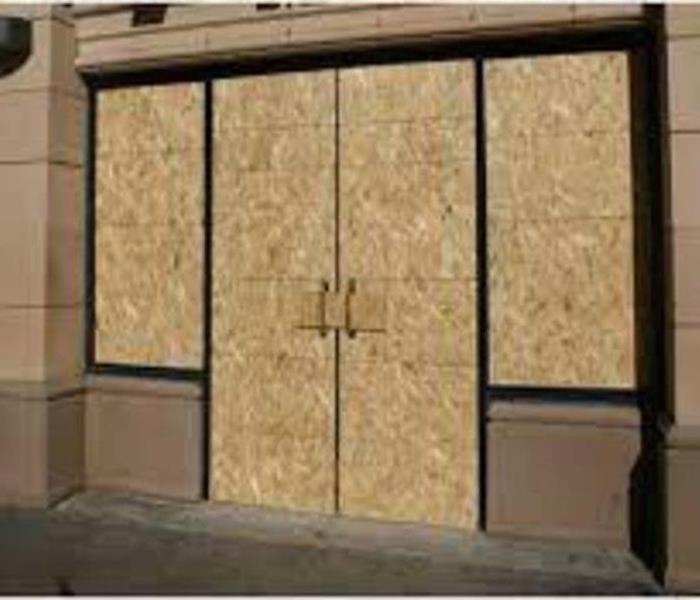 When disaster strikes your home, don't dwell on your loss and forget that you still have the power to reduce further losses with board up services.
When disaster strikes your home, don't dwell on your loss and forget that you still have the power to reduce further losses with board up services.
What are Board Up Services?
Your windows are among the most vulnerable entry points in any business. After all, whether you're talking about vandals or high winds, glass is easier to break than solid wall.
Regardless of the reason your windows are damaged, you may not be able to replace them right away. In fact, if a natural disaster is the reason your windows are broken, local installers are probably already inundated with replacement requests. When your appointment is delayed, you should pursue board up services for peace of mind.
Reasons to Seek Board Up Services
Different situations may cause your windows to break, leaving your home exposed. Here are a few of the most common examples:
- Storm damage: Windstorms, tornadoes and hurricanes pack a powerful punch. The pressure differential between the inside and outside is sometimes enough to shatter windows. Then there's the possibility of debris being hurtled at your windows while traveling hundreds of miles per hour, smashing the windows on impact.
- Fire: Heat from a structural fire can cause a surprising amount of damage to your business, including shattering glass windows.
- Property vacancy: Foreclosed and abandoned properties are often left with broken windows. Board up services play an important role in preserving the business from further damage or vandalism until someone new buys the property.
- Preventative measure: It's wise to plan ahead with board up services when a big storm is in the forecast. This preventative measure can protect your windows from breaking in the first place. Then after the storm passes, you simply have the boards removed to restore your business to its former condition.
What to Do After a Fire at Your Business
9/13/2022 (Permalink)
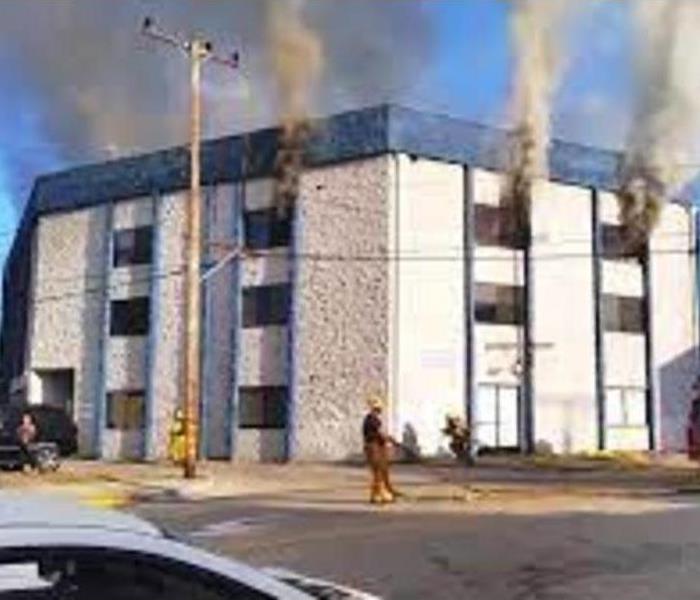 Fires cause serious damage to thousands of businesses in the United States and Canada every year.
Fires cause serious damage to thousands of businesses in the United States and Canada every year.
What to Do After a Fire: Recover Your Business
The most important thing to do after a fire is to stay calm. The scene may be chaotic, but a level head will help you and your coworkers take control of an unpredictable situation.
Ascertain the safety of any people or animals present at the location. You can worry about property damage after everyone is safe. Resist the urge to enter the building until firefighters have told you it’s safe.
Surprisingly, as a side effect, firefighters’ efforts can cause extensive damage on top of the fire itself. Firefighters may have been forced to cut holes in the roof, smash windows or move equipment to put out the fire. There may also be extensive water damage from the firefighters’ hoses or your sprinkler system. If your business has succumbed to water damage as a result of fire fighting efforts, call SERVPRO of Streamwood, Bartlett, West Chicago and Warrenville to repair and restore.
What to Do After a Fire at Your Business: Step-By-Step
There will be a lot to do after a fire at your business. To keep from becoming overwhelmed, utilize your custom Disaster Preparedness Plan and Business Continuity Plan (drafted in advance of a disaster and revisited annually) to make smaller task lists addressing each area of your business.
Here are ideas for what to do after a fire at your business:
- Keep a notebook with you to document everything.
Take special note of everyone you talk to, their contact information and your conversations. Note any expenses in the aftermath of the fire and keep all your receipts in one place.
- Photograph everything.
Before you begin to clean up, restore and remediate, it’s vital that you document the damage, as this may be pertinent to insurance claims or law enforcement investigations.
- Contact your insurance company ASAP.
The more prompt you are in contacting your insurance company, the more they can help you. Ask questions until you are sure you understand everything and take notes.
- Call SERVPRO of Streamwood, Bartlett, West Chicago and Warrenville
STEPS TO RESTORING A COMMERCIAL BUILDING AFTER WATER DAMAGE
5/3/2022 (Permalink)
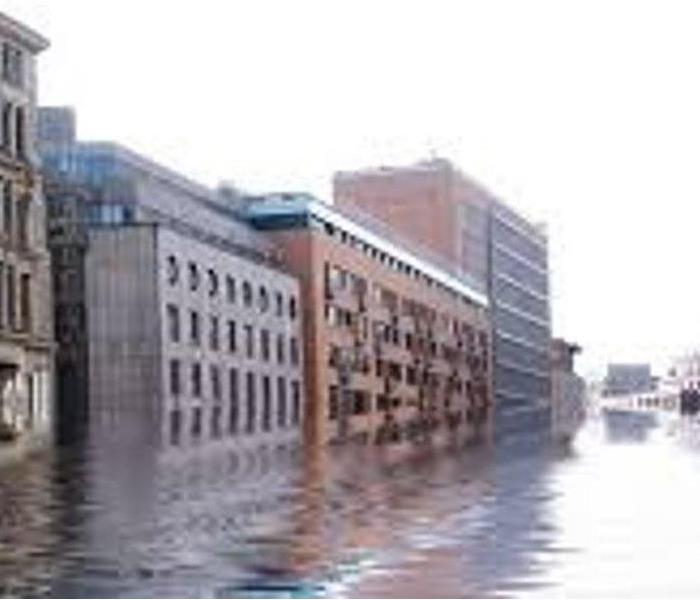 Water damage can be a catastrophic event but when the building is a commercial enterprise it can be debilitating if not handled properly.
Water damage can be a catastrophic event but when the building is a commercial enterprise it can be debilitating if not handled properly.
Step 1: Determine the Risks
Electrical Hazards
Electrical Hazards can include power strips in offices getting wet, water from above impacting junction boxes, lights, fire alarm systems etc. All power to impacted areas where electrical systems could be impacted should be immediately shut off at the circuit breaker panel if safe to do so. A qualified electrician should be hired to assess any damages and to ensure all areas are safe from shock hazards.
Slip and Fall Hazards
Slip and fall hazards are some of the most common hazards in any water damage event. Every effort should be made to reduce risks to include water removal, proper warning signs and restricting access to damaged areas.
HVAC System Contaminations
HVAC systems should be assessed to determine if any moisture has impacted the system. Contaminated water poses an imminent risk to occupants in the building due to the risk of bacteria, and other microorganisms becoming airborne. Even clean water when stagnant in the HVAC system for an extended period (typically over 48 hours) rapidly degrades and can result in deteriorated air quality and potential exposure risks. After water damage events impacting a mechanical system, a qualified HVAC expert should assess the system and the associated ductwork should be cleaned by a NADCA certified firm.
Bacterial Contamination
Category 1 or “clean” water damage situations are much less of a risk in terms of immediate health risks to occupant health and safety. Category 2 (contaminated water with potential risk of harm such as groundwater) and category 3 (significant contamination such as sewage) water damage disasters pose a much greater risk to occupant health due to potential viruses, bacteria, chemicals, and disease-causing pathogens typically present in this type of water. Immediate evacuation of occupants is often prudent in category 2 water damage events and is almost always required in category 3 water damage events.
Step 2: Mitigate Commercial Water Damage
Proper mitigation during water damage is a critical step in restoring a building–but what exactly does mitigation mean with respect to restoring a building? Mitigation involves removing all excess water, quickly identifying salvageable vs non-salvageable building materials/contents, quickly identifying class 4 areas of damage which are difficult/technical drying challenges with bound moisture and establishing a restoration plan for demolition and drying. The ultimate goal of mitigation in commercial settings is to dry the structure with as little demolition as possible and to limit downtime of the operation.
The Key to Success is Having a Water Damage Clean up Process in Place
Good communication throughout the entire process is key to a successful outcome. This includes communication with facilities management, subcontractors, water mitigation techs, etc. Every step should be thoroughly documented, including photos, notes, and moisture mapping. A pre-set disaster emergency response plan is the best way to ensure a rapid response and timely building restoration. Most progressive companies have some type of plan in place which should include all of the building’s mechanical information, electrical layouts/shut-offs, water shutoffs, location of critical documents, staging areas and contact information for key employees/contractors.
No one ever wishes for a water damage event to strike their building, but chances are that at some point you’ll be the victim of a water damage disaster. When disaster does strike have a plan already in place and more importantly ensure you call in a qualified expert, such as SERVPRO of Streamwood, Bartlett, West Chicago, and Warrenville to perform the required mitigation. With a well thought out and well-executed mitigation/drying plan you’ll be up and running in no time.
Types of Fire Doors for Your Commercial Business
5/3/2022 (Permalink)
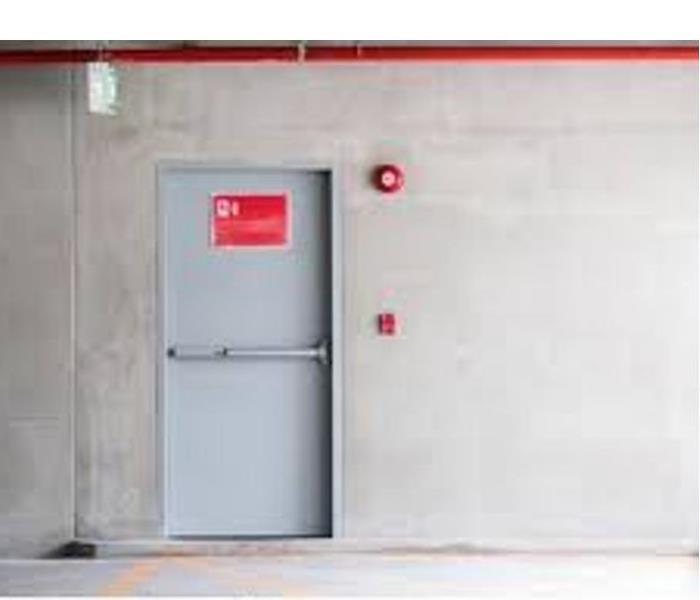 Choosing the correct fire doors for your business could be crucial.
Choosing the correct fire doors for your business could be crucial.
In the case of a fire, fire doors are necessary. They can buy valuable time, allowing residents to safely flee a structure. In the event of an emergency, they are critical not only for providing a clear and secure escape route but also for reducing the spread of flames and smoke. Because fire doors have the potential to save lives and reduce long-term damage, they must adhere to the building's strict health and safety rules.
The effectiveness of a fire door, as well as the type required, are determined by its location in the building and the types of fire dangers it faces. There are many various types of fire doors, ranging from different materials to different fire ratings and levels of protection.
Fire doors made of glass
It's hard to think that glass is a fire-resistant material, yet thanks to sophisticated fire technology, it's just as excellent as any other. It's crucial to understand that glass fire doors must be built of fire-resistant glass. This indicates that the glass has undergone the necessary fire testing and has been certified as fire-resistant.
The E certification denotes that the fire door glazing will remain transparent when exposed to fire or heat, allowing for maximum visibility and light transmission. It also implies that the glass will only impede the spread of fire and smoke, but not heat transmission. The number following the E classification grade indicates how long it will take for fire-rated glass to properly segregate regions and prevent fire and smoke from spreading.
Toughened fire glass can resist temperatures of over 1600°F, whilst normal glazing can only withstand temperatures of 250°F. Glass fire screens, and doors can also provide up to 120 minutes of fire protection. Following are the classes and classification of glass fire rated doors and screens :
- Class E: This is the most basic form of fire-resistant glass available. It can contain flames and smoke for a long period, but it can't stop heat from radiating from the source from being transmitted or transferred.
- Class EW: This is the second type of fire-resistant glass that can effectively contain flames and smoke for an extended period. It does, however, provide some insulation or resistance to the heat radiating from the source.
- Class EI: This is likely the benchmark in terms of fire-resistant glass, as it provides a broad range of protection. It protects individuals not only from fire and smoke but also from the heat radiated by the fire source.
- Fire doors E30: A glass door or screen with an E30 rating can defend against the spread of smoke and flames for 30 minutes in the case of a fire, providing a half-hour opportunity for anyone in the building to locate a safe escape path.
- Fire doors E60: E60 is a higher grade for glass fire screens and doors, indicating that it can endure heat and smoke for 60 minutes without losing its integrity and stability.
- Fire doors E120: The highest-rated fire-resistant glass is given an E120 rating, indicating that it can withstand the pressure of fire and smoke for up to 120 minutes before losing its effectiveness.
Fire doors made of wood
The British Woodworking Federation assigns an FD rating to timber fire doors to indicate their level of protection. Another prominent organization that supplies fire door ratings is the British Woodworking Federation (BWF). The BWF fire ratings for fire door assemblies are expressed in minutes and preceded by the initials FD: for example, FD30 stands for a 30-minute fire door or fire door set, which means it provides at least 30 minutes of fire protection.
The following are the most regularly used integrity levels:
- FD30 is for 30 minutes,
- FD60 is for 60 minutes,
- FD90 is for 90 minutes, and
- FD120 is for 120 minutes.
The current FD20 rating is no longer available as part of the BWF's efforts to simplify fire door identification and avoid specification misunderstanding.
Certified Fire Doors
Fire door sets can be certified by manufacturers for recognition and to ensure their functionality in a fire situation. The manufacturer's initial step is to build a fire door set to a specification that, in their opinion, will withstand a fire for a defined period.
BWF has its Certified Fire Door Scheme, in which they collaborate with FIRAS installers to ensure that the doors are installed according to their specifications. All fire doors that have completed the British Woodworking Federation's tests will be granted a BWF-CERTIFICATE, which will state the door's rating and ensure that it has been properly tested and is safe to use.
How to create a fire protection and prevention plan for businesses
5/3/2022 (Permalink)
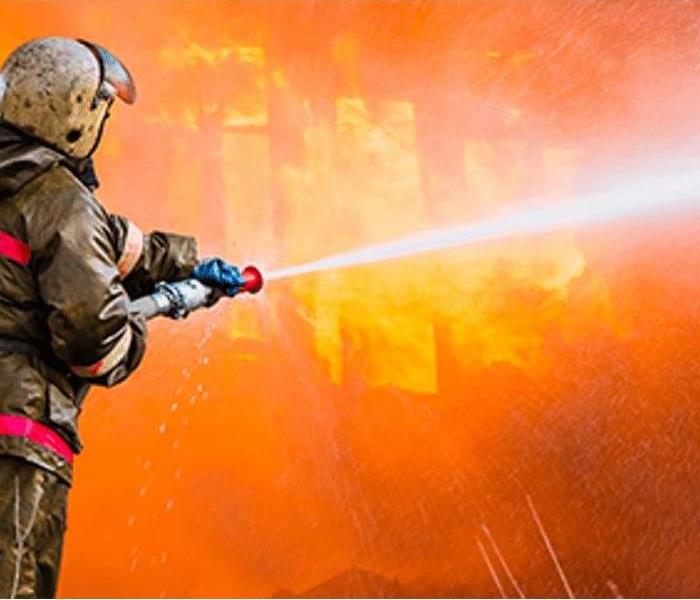 Commercial businesses need to create a fire protection and prevention plan.
Commercial businesses need to create a fire protection and prevention plan.
As one of the greatest hazards that a business can experience, fire rates near the top. Each year, several thousand lives are lost to fires, tens of thousands of people are seriously injured, and billions of dollars in property is destroyed or damaged by fires. Commercial businesses guard against this risk by sharing these best practices for a fire protection and prevention plan as part of their risk management plan.
Most fires can be prevented by using proper building materials, plus identification and protection of special hazards. The use of detection and suppression equipment, along with education and involvement of the organization’s senior management are also key prevention considerations on which we’ll take a closer look.
Before a fire: Prepare and launch your fire protection and prevention plan
Establish an Emergency plan that takes prevention, emergency response, and disaster recovery into consideration. If a plan is already in place, review and update it as needed for fire readiness.
Before you create your pre-fire plan, you’ll need a solid understanding of your building’s construction, floorplan and occupancy. This helps firefighters and other emergency response personnel to more effectively resolve a crisis.
Observe not only the building’s layout and construction materials, but also parking lot entrances, hydrant locations and nearby structures. Include a floorplan of each level that shows elevators, fire escape stairwells, heating and air conditioning equipment, smoke detectors, fire alarms, sprinkler systems and controls, and utility shutoffs.
Your commercial business should also conduct a hazard assessment and safety appraisal of the facility and its operations.
In launching a fire protection and prevention plan, be sure to include the following:
- Smoking regulations that are supported and enforced by management.
- Safe procedures for handling and storing flammable gases and liquids.
- Safe means of performing hot work (e.g., welding).
- A thorough description of good housekeeping methods such as not allowing rubbish to accumulate or aisles to be blocked.
In developing the plan, your business may discover they need to install or upgrade various fire prevention features. They may need to upgrade their facility to meet current fire codes. If so, remind them to use noncombustible and fire-resistant building materials. Additionally, encourage them to follow these safety tips:
- Ensure the preventive maintenance program for operational equipment (building utilities, processing equipment and material handling equipment) meets manufacturer’s specifications and industry standards.
- Install fire detection systems (e.g., fire alarm systems) and fire suppression systems (e.g., fire extinguishers, sprinkler systems, and carbon dioxide) in the building, particularly in hazardous locations.
- Keep an adequate number of appropriate fire extinguishers in strategic locations (such as near loading docks and waste collection areas). Maintain them properly and train staff on their use.
- Test all fire and life safety detection and suppression equipment per local and national fire codes.
- Consider maintaining a water supply at the facility to control small fires until emergency personnel can arrive.
- Ensure there’s an adequate water supply for the sprinkler system. Evaluate the water supply’s volume, pressure, and duration (e.g., pressure, suction, or gravity/elevated tanks).
- When reservoirs, ponds, rivers, and other similar bodies of water are used to supply the sprinkler system, evaluate how any unusual weather conditions such as winter freezes or extremely hot weather may affect supply.
- Have available appropriate tools such as rakes, axes, saws, buckets and shovels to help control small fires while waiting for emergency personnel to arrive.
- Meet with the local fire department to familiarize them with special hazards and emergency procedures.
- Develop mutual aid agreements with other companies.
- Keep a list of all vendors’ and key customers’ telephone numbers and other important contact information available and secured.
- Provide a warning system for all personnel on the premises.
Protect employees
- Train employees in general fire safety, especially for tasks with a high fire risk such as welding and cutting, fueling vehicles or working with flammable liquids.
- Teach employees about the importance of good housekeeping and grounds maintenance in preventing and controlling fires.
- Train key employees in when and how to use fire extinguishers.
- Consider when and how to evacuate employees if needed.
- Establish an evacuation plan and keep it up to date.
- Hold evacuation drills regularly so all employees are familiar with evacuation routes and routines and know who’s in charge.
- Make sure all employees can get out of the building and communicate with a responsible person.
- Plan primary and secondary exits from your buildings. Consider how employees will escape if doors or windows are blocked by an exterior fire.
Once your business' emergency fire plan is in place, they’ll need to provide it to local fire officials and update it on a regular basis.
During a fire: Enact your fire protection plan
- Identify the affected area and sound the alarm.
- Call the public fire department.
- Evacuate all visitors and employees.
- Position security staff at the front entrance of the building (or wherever appropriate) to meet, brief, and escort the fire department.
- When directed by the fire department, notify the electric company to cut off electric power to the facility.
After a fire: Begin recovery
- Conduct a roll call of all personnel, including visitors.
- Assess the structure for damage.
- If there is no power, check to make sure the main breaker is on. Fires may cause breakers to trip. If the breakers are on and power is still not available, contact the utility company.
- Inspect all other utilities and turn off those that are damaged.
- ALWAYS contact 911 if any danger is perceived upon re-entry and contact local experts before finally moving back in.
- Protect equipment and inventory against further damage from water or exposure to the elements.
- Restore fire detection and suppression systems.
- Arrange for security at the scene.
- Call your insurance company to begin a claim.
- Photograph and document the damage.
- Begin salvage operations.
Benefits Of A Professional, Commercial Cleaning Service & Why Every Business Needs One
10/5/2021 (Permalink)
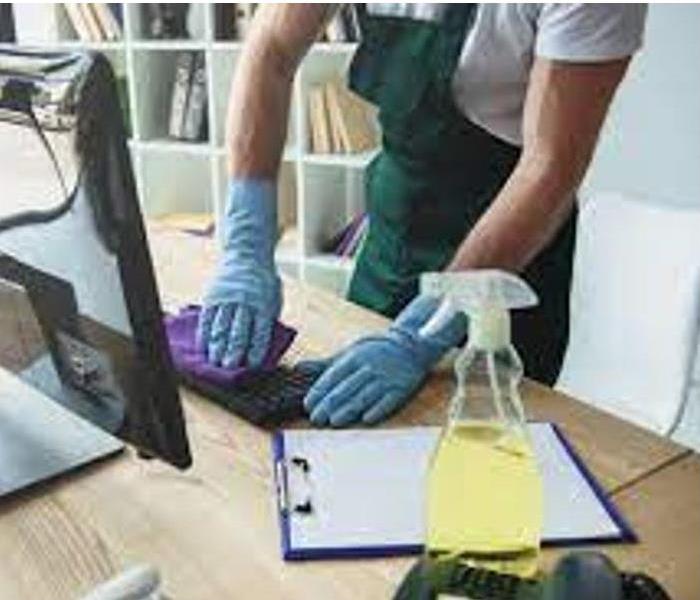 Your employees are happier when the workspace is fresh, clean, and free from accumulated dust and dirt.
Your employees are happier when the workspace is fresh, clean, and free from accumulated dust and dirt.
Americans spend most of their waking hours at work. While many businesses use a cleaning service, the actual cleaning performed is often minimal, with a quick vacuum and emptying of trash. Deeper dirt, dust, allergens, and pathogens remain in carpets, on blinds, and deep within the upholstery of office furniture. Read about the benefits of professional commercial cleaning, and why your business should consider investing in a high-quality cleaning from SERVPRO of Streamwood, Bartlett, West Chicago & Warrenville.
Increased Employee Productivity
Your employees are happier when the workspace is fresh, clean, and free from accumulated dust and dirt. The air smells sweet and is healthier to breathe. While many businesses understand the need for ongoing employee training and recognize that healthy company culture is important, very little thought may be paid to the most important factor in productivity – pure, clean air.
While it is well-established that polluted air is a risk to human health, many business owners may not realize the significant impact of unhealthy indoor air. Within the walls of a business, the air may be contaminated with particulate matter, all of which is continuously circulated by the HVAC system. Research reveals that polluted indoor air quality leads to a significant drop in productivity. It is believed that dirty, unhealthy indoor air diminishes human cognitive function.
A Safer, Healtheir Work Environment
Employee health has become an issue of concern, more so now than ever. Many businesses are interested in a more environmentally-friendly operation. A professional commercial cleaning service can use safer, “green” products so that toxins do not linger in the air and the environment is not filled with perfumed cleaning products that can trigger a reaction in many people. If you want to provide a safe, healthy environment for your employees, clean, fresh air matters.
The air ducts in your business must be regularly cleaned to keep free from pathogens. The procedure used in duct cleaning can vary. To fully extract allergens, bacteria, dust, dirt, mold, and debris, a state-of-the-art, advanced extraction system should be used. Removing all harmful contaminants on a yearly basis can help keep business indoor air quality fresh, with the added benefit of reducing energy costs, as your HVAC system will perform more efficiently.
Allergies affect many people and are one of the top three reasons employees miss work. At SERVPRO of Streamwood, Bartlett, West Chicago & Warrenville, we understand how to limit the spread of disease through a professional cleaning process. Employees carry allergens from home to work, including pet hair and dander, dust mite eggs, and other substances into the business. Frequent carpet and upholstery cleaning, along with standardized processes to fully remove dust and allergens from surfaces, goes a long way in keeping your employees functioning at their best.
A Positive, Professional Appearance
Contrast two ideas: Walking into a business that has stained carpet, dusty desks, and trash overflowing with crumpled paper and takeout cartons or walking into a business that looks pristine, smells fresh, and is obviously clean. The image you project to customers is an important factor in the success of your operation. A shoddy appearance creates the impression that your business performs shoddy work. A smart, clean, sanitary appearance, with air that smells fresh and sweet, produces a subtle impact on customers, clients, and visitors to your enterprise – and higher confidence in your business goods or services.
Good business “housekeeping” includes several critical steps. Some of the more obvious are reducing clutter accumulating in stairways, halls, and other walking areas, keeping trash bins clean, rather than just replacing bags, along with effective dust and dirt removal performed daily. Standard vacuums, even larger models often used by small commercial cleaning companies, do not offer the option of HEPA filters, which are needed in businesses that work with hazardous substances. No matter what industry, at SERVPRO of Streamwood, Bartlett, West Chicago & Warrenville, our team of professionals has the correct equipment for the job at hand.
Many areas must be thoroughly cleaned every day, while others will require periodical maintenance.
Commercial Water Damage
10/5/2021 (Permalink)
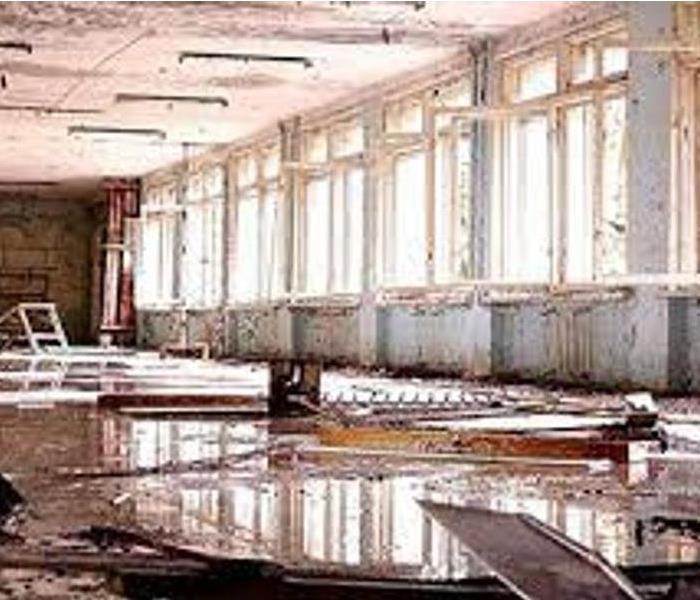 When there’s a need for commercial water damage service, the scale and consequences of damage are often more extensive.
When there’s a need for commercial water damage service, the scale and consequences of damage are often more extensive.
When there’s a need for commercial water damage service, the scale and consequences of damage are often more extensive than residential incidents. Potential losses may be greater, as well, as critical equipment and products may be endangered and a normal business interrupted. Company workers may also be facing a disruption in income because the affected building is not habitable.
Here are some other reasons why commercial water damage can be specifically challenging:
- Higher water pressure. Commercial buildings often utilize higher water pressure to service the larger structure plus specific needs relating to the company business. That means a greater volume of water may be released faster into the building in the event of a ruptured water supply line.
- Larger roof area. Because of the typically larger square footage of a commercial building, the potential damage from roof leakage is also more likely. Since many commercial roofs are flat, leakage from deep standing water on the roof due to inadequate or blocked roof drainage is also more prevalent.
- Hidden damage. Commercial buildings often incorporate more areas of the structure where water damage can occur without immediate notice. Plumbing pipes are often routed through unseen or seldom-visited areas.
- Unoccupied premises. Because commercial buildings are often not occupied for long periods over weekends and holidays, water damage occurring in that time frame may be very advanced by the time it’s discovered.
Commercial Water Damage Service
Water damage in a commercial building can mean a substantial reduction of revenue as well as lost customers. SERVPRO of Streamwood, Bartlett, West Chicago, and Warrenville takes into account the unique requirements of a business, including:
- Rapid response—24/7/365—to return all company functions and services to normal operation, ASAP.
- Site security while water damage recovery services are underway.
- Techniques to isolate water-damaged areas of the building from unaffected areas in order to keep as much of the company operational as possible.
- Attention to preventing ancillary issues such as excessively high indoor humidity that damages business paperwork and documents.
6 Types of Insurance Every Small Business Needs
9/29/2021 (Permalink)
 Coverage you need as a small business owner to protect yourself, your business, your employees, and your customers.
Coverage you need as a small business owner to protect yourself, your business, your employees, and your customers.
Running a small business can be overwhelming — in the midst of wearing so many hats, things like finding the right business insurance coverage can sometimes be pushed aside. But it’s important to remember that without the necessary coverage, everything you’ve worked for can be lost in the blink of the eye, with one large claim you can’t recover from.
From customer slips and falls to your employee’s laptops to dropping a hammer while working on a house, there are so many things that business insurance protects you from. We’ve made it easy and quick for you by laying out the 6 types of coverage you need as a small business owner to protect yourself, your business, your employees, and your customers.
1. Property Insurance
Commercial Property Insurance is imperative to your small business, whether you own the building where your business is located or not. Here are the two basic parts: 1) If you own the building, you will have to insure the property to its replacement cost; 2) Whether you own the property or not, you will need to insure everything inside the property, which is also known as “Business Personal Property Insurance.” This insurance will ensure coverage of everything inside your office, from computers to phones to conference tables — even your desk!
Theft, vandalism, fire, malicious mischief and wind damage are other perils covered by property insurance. Property insurance is included in standard “BOPs” or Business Owner Policies.
2. General Liability Insurance
General Liability Insurance provides protection if you, your employees, your product, or your services are considered negligent and cause bodily injury or property damage. It protects your business against claims that occur while customers are on your premises. Say you own a restaurant — General Liability Insurance covers you if a customer were to trip and sprain their ankle in your restaurant. It also includes products coverage in case a patron gets food poisoning from your product.
If you are a contractor working on a home remodel and a neighbor walks by and trips over an extension cord you’ve accidentally left exposed on the sidewalk; General Liability Insurance covers “Bodily Injury to Others,” in this case, due to negligence. Say the contractor accidentally drops their hammer on a neighbor’s car — GLI also covers this “Property Damage to Others.”
3. Loss of Business Income Insurance
Loss of Business Income Insurance will cover your net profit, or the “Actual Loss Sustained” if you go out of business for a period of time. For example, if your business runs from a brick and mortar location and a fire puts you out of commission for three months, this policy will cover your net profit you would have made in those three months. It will give you the peace of mind necessary to make changes in order to recover!
4. Workers’ Compensation Insurance
Workers’ Compensation insurance provides wage replacement and medical benefits to employees injured in the course of employment. Did you know it also relinquishes the employee's right to sue his or her employer for the tort of negligence? By accepting workers’ compensation benefits, the employee gives up this right.
Small business employers can help control Workers’ Compensation costs by instituting a formal safety plan aimed at preventing claims from occurring and minimizing the loss when they do. Having a safety manual in place and giving proper workplace safety instructions to all of your employees is critical to keeping them safe and your costs down!
5. Cyber Liability Insurance
A data breach to your small business can be crippling. If your business stores private information about employees or clients, it is your responsibility to protect that information. Moreover, if a data breach occurs, you are obligated to notify all of your employees and customers, which can be an overwhelming and expensive task. Cyber liability insurance will cover the expenses incurred in doing so.
You should also know if the limits provided in your current Business Owner Policy are adequate in the event of a data breach loss. The average annual cost of cyber attacks to small and medium-sized businesses was nearly $200,000 in 2010. Business owners may not realize that cyber liability coverage included in Business Owner Policies will generally only provide lower limits. This means it’s important to talk to your insurance agent about a more robust, stand-alone cyber insurance policy for your business. In addition, it is important to know if your Umbrella Liability policy will provide coverage over and above the Cyber Liability limit.
6. Umbrella Policy
An Umbrella Policy extends the coverage of all of your policies — think of it as an actual umbrella protecting you from the rain. An umbrella policy will provide additional liability limits over and above those provided by your other policies in the event of a larger claim. For example, if your General Liability or Commercial Auto Insurance has a limit of $1 million, and you have a claim or lawsuit against you for $1.5 million, the umbrella policy will cover the extra $500,000. You don’t want to find yourself in a situation where your General Liability Insurance isn’t enough coverage and you’re paying hundreds of thousands of dollars to make up for that mistake.
Small business insurance is equally important and complex. You worked hard to create your business. Don’t lose it by having inadequate insurance coverage!
Fire Sprinklers And Why Do You Need Them?
9/29/2021 (Permalink)
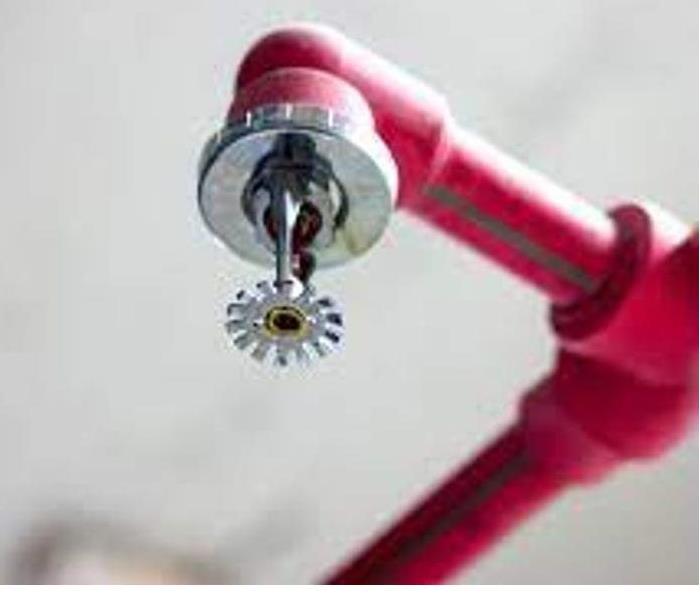 To minimize the damage, fire sprinkler services are the best way to protect your people and your assets from a fire.
To minimize the damage, fire sprinkler services are the best way to protect your people and your assets from a fire.
Unfortunately, despite all the advancements in commercial fire protection, fires still happen all the time. Despite our best efforts to prevent them, they happen. And when they do, they can be devastating, especially if they are allowed to spread uncontrolled. To minimize the damage, fire sprinkler services are the best way to protect your people and your assets from a fire.
Yet even though these devices are ubiquitous in commercial buildings, most people have absolutely no idea how these devices really work. To answer questions you didn’t even know you had, keep reading for a beginner’s guide to commercial fire protection and modern fire sprinklers.
What Are Fire Sprinklers?
We’ve all seen them at schools, hospitals, hotels, etc. These sprinklers are an essential part of a fire protection service. Obviously they are designed to dispense water when a fire is detected; however, they are carefully designed to only dispense water when a fire is actually present. The fire sprinkler system design typically places the sprinklers in the ceiling of a building so that the water can reach every area of the room in order to put out a fire.
How Do Fire Sprinklers Prevent False Alarms?
When you consider the amount of electronic equipment in the average building and home, it’s clear that the effects of a false fire sprinkler activation would be extremely expensive. To prevent this, fire sprinklers are designed so that they can only be activated when a fire is actually present. To prevent false alarms, modern fire sprinklers contain some sort of obstruction, usually made from glass or wax, that prevents water flow. Only under extreme heat are these obstructions released, allowing water to flow only when it’s supposed to. While fire sprinklers can be easily set off in movies and TV shows, usually for comedic effect, this just doesn’t happen in real life. Of course, to ensure they work when you need them to, most cities require regular fire sprinkler inspections.
Why Do You Need Them?
The first major reason that sprinklers are critical to install in any building is for safety. Sprinklers can literally save lives. Just as importantly, sprinklers prevent a fire from spreading. The sprinkler system not only controls the flames of a fire, it also helps control the smoke. The toxic fumes that can be inhaled from a fire’s smoke are the deadliest part of a fire; the smoke can harm or kill someone before the fire even gets to them. Sprinklers can help reduce this risk greatly.
Protecting your business is the second major function of sprinkler systems. Structural damage is greatly reduced in a fire when sprinklers are present, saving a lot of potential money in repairs. Sprinkler systems only dispense the smallest amount of water necessary to turn potentially deadly flames into smaller ones, which means that you don’t have to worry about excessive water damage either.
Keep Your System Up and Running
Now that you know how important sprinklers are, you need to understand the equal importance of fire sprinkler repairs. If you have a system that is no longer functioning, then it is of zero use to you. Lives will not be saved and damages will not be prevented. Having regular fire sprinkler inspections can save you from some serious consequences in case of a fire. Plus, it will keep you compliant with local fire safety codes.
If you own a business or commercial property of any kind, remember the importance of having a working sprinkler system in your building. You can save lives and money down the road. Don’t forget the need for fire sprinkler repairs, either. Your system can not protect you if it does not work.
Protect Your Commercial Building from Water Damage
9/22/2021 (Permalink)
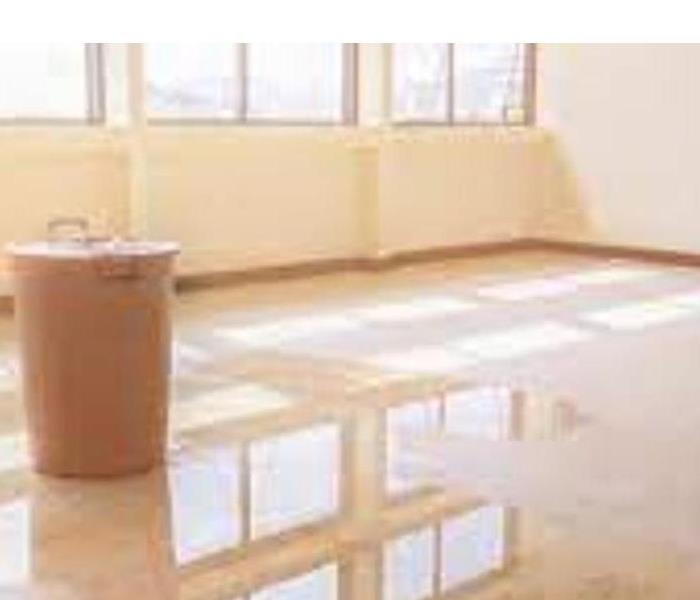 Follow these steps to help safeguard your commercial building.
Follow these steps to help safeguard your commercial building.
Follow these steps to help safeguard your commercial building and its tenants from flood and flood-related losses.
Get covered. Typically commercial property insurance does not provide protection against floods and flood damage. As a result, evaluate your commercial building insurance coverage and consider adding flood insurance,
Assess your situation. Commercial buildings in low-lying areas or flood plains may be at higher flood risk than those set high atop a hill. But location aside, all commercial properties possess their own vulnerabilities. Understand and address the risks of your building to shield against floods.
Waterproof. Floodwaters don’t have to reach record numbers to negatively affect your commercial property. Even small amounts of water breaching the interior can lead to damage. Limit the destruction by sealing cracks and weaknesses, and adding a layer of waterproofing material to your commercial structure.
Make a plan. Flash flooding can happen in, well, a flash. To best protect your commercial property, as well as the tenants and possessions within, be sure to put an emergency action plan into place. Included in such a plan should be:
Always be ready. Minimizing potential water damage to your commercial building may just start with routine maintenance. Ensure that gutters and drains are clean and clear and that sump pumps are in proper working order. Take steps to move valuable business items off floors if under a storm watch or warning. Only attempt this if personal safety isn’t at risk. Also, disconnect electrical, including appliances, computers, and other equipment.
The better prepared your commercial building is for an impending flood, the more control you might have to prevent water damage. But even the best of measures doesn’t always protect you completely. Should water cause disaster to your commercial property, our restoration and remediation specialists are here to help you respond to the aftermath and return your property to preloss conditions.
6 Fire Alarm Installation Mistakes to Avoid for Businesses
9/15/2021 (Permalink)
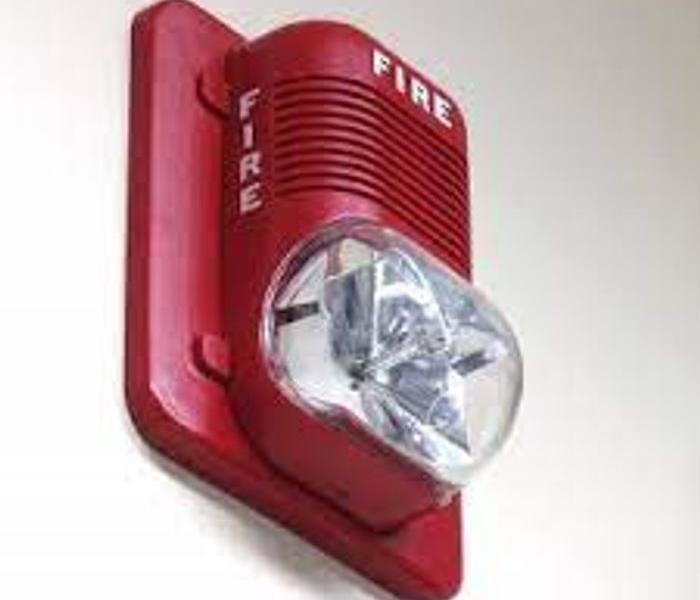 Installing a fire alarm and ensuring it works properly are steps in the right direction to keeping your company safe.
Installing a fire alarm and ensuring it works properly are steps in the right direction to keeping your company safe.
Installing a fire alarm and ensuring it works properly are steps in the right direction to keeping your company safe.
Read on to learn about six fire alarm installation mistakes to avoid for businesses.
1. Setting False Alarms
Fire alarms can be life-saving, but they can also be annoying if they are constantly setting off false alarms. False alarms can lead people to believe that there is no threat when there is.
To prevent false alarms, fire alarm installation should be away from doors and ducts. Drafts are often the cause of false alarms.
2. Installing Near the Kitchen
There are certain locations for alarms that are necessary for proper installation. If your business has a kitchen area, it is important to keep your fire alarm away from it.
Fire alarm sensors can get triggered if they are close to appliances like ovens. A fire alarm should get installed about 20 feet away to avoid causing combustion particles.
3. Not Interconnecting Alarms
No matter the types of alarms you use, they need to interconnect. Smoke alarms work together to protect your entire business. No matter where the fire is, the system can warn you.
When one fire alarm sounds, they should all sound. This is especially important if you have a relatively large company. During fire alarm installation, ensure that each alarm is interconnected for maximum protection.
4. Installing One Fire Alarm Type
Because there are different types of alarms, they can detect different fires. For example, ionization alarms can detect actual flames while photoelectric alarms can respond to smoldering fires.
To make your business as safe as possible, install both types of fire alarms. Dual-sensor alarms are also available that works with both alarm types.
5. Forgetting to Test the Alarm
Fire alarm batteries can be tricky. You may think they are right when they are not. This is why it is important to test the alarm after the installation.
After testing it the first time, the maintenance does not stop there. Fire alarm maintenance includes testing your alarm once a month.
About every six months, the batteries should get replaced. This is not the case with newer alarms that have a long-lasting battery already.
Your fire alarm will usually let you know when the battery needs replacement. A chirping alarm means you have to replace the battery as soon as possible.
6. Incorrect Installation
A fire alarm installation should be done correctly. It can come with some difficulties like choosing the right rooms and deciding if drilling needs to be done.
Always read the instructions before installation or have an expert help you. These alarms should be at least 10 centimeters from the wall.
Fire Alarm Installation Made Easier
Fire alarm installation is now made easier when you avoid these common mistakes. To keep your business as safe as possible, alarms need to be installed the right way.
How to Prevent Commercial Fire Damage
5/11/2021 (Permalink)
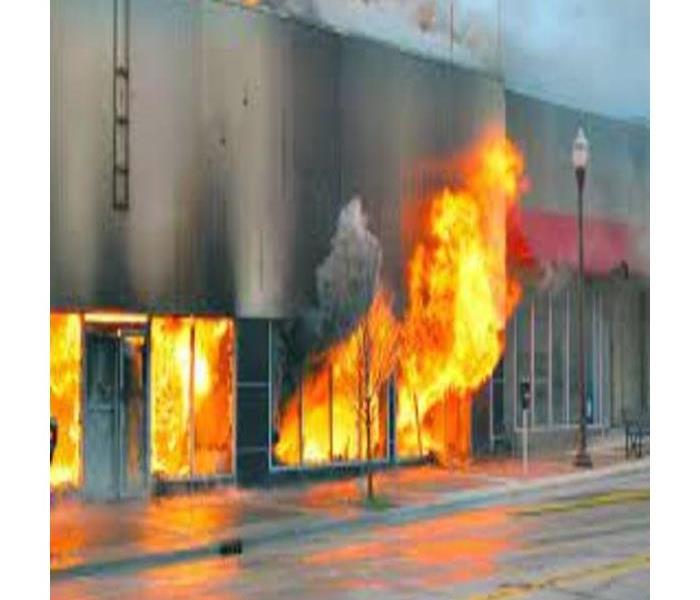 Prevent Commercial Fire Damage
Prevent Commercial Fire Damage
Fire prevention is vital to avoid property losses. Here are some tips to protect against a commercial fire.
- Create an emergency plan. Take time to prepare an emergency plan and discuss it with employees and building staff.
- Educate employees about fire safety. Since most commercial fires are caused by cooking equipment, office kitchen fire safety tips must be encouraged. Appliances must be unplugged after use. Employees must also be trained regarding the proper use of a fire extinguisher. Most importantly, employees must also familiarize emergency protocols and emergency routes and exits should a small fire go out of control.
- Perform routine inspections of office equipment. Office equipment must be checked regularly to ensure that they are in good working condition. Frayed electrical cords, damaged electronics and appliances, and malfunctioning heating, electrical, and lighting systems must be attended to immediately.
- Perform routine inspections of office equipment. Office equipment must be checked regularly to ensure that they are in good working condition. Frayed electrical cords, damaged electronics and appliances, and malfunctioning heating, electrical, and lighting systems must be attended to immediately.
- Install smoke detectors and alarms. Smoke detectors are among the items that can actually save lives and are the most effective things you can install for fire prevention in the workplace. Install the best ones you can afford and inspect them regularly.
- Check sprinklers. Automatic sprinklers can help mitigate the impacts of commercial fires. Utilize them in conjunction with a warning system, such as smoke detectors.
Why Commercial Water Damage Happens
5/11/2021 (Permalink)
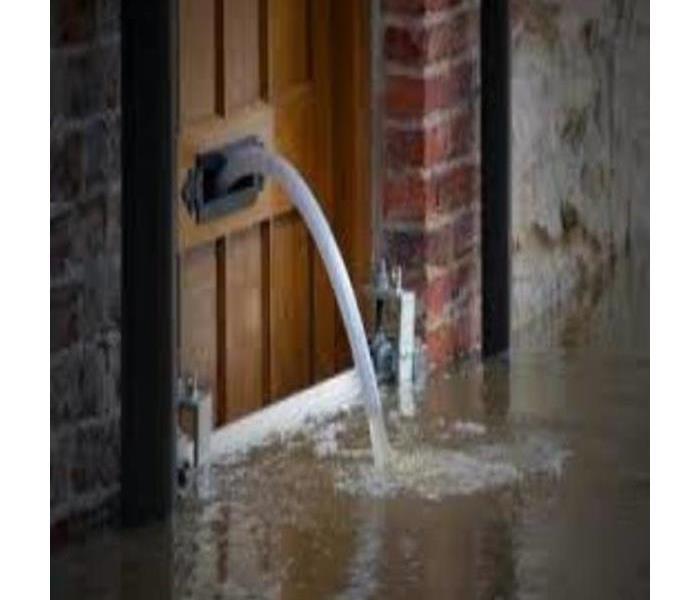 Different Reasons for Commercial Water Damage
Different Reasons for Commercial Water Damage
When water damage impacts your business, the problem could cost a lot of money in repair costs as well as downtime for the company. What are the most common causes of water damage in commercial establishments? How can these be prevented?
Water damage sometimes occurs in businesses due to the lack of proper maintenance procedures. Although accidents also occur, it is best if all equipment in business be placed on a preventive maintenance plan to ensure that the possibility of breakdowns and subsequent water damage is kept to a minimum.
- Sprinkler system malfunction – Older buildings with outdated sprinkler systems are more prone to sprinkler malfunctions than newer buildings with modern systems. If you are leasing space in an older building, be wary of potential malfunctions for fire safety reasons.
- Malfunctioning appliances – Coffee shops, restaurants, and offices that have appliances in their break rooms, or water fountains in the hallway, can experience water damages when the appliances malfunction.
- Broken and corroded pipes – Another problem that may trigger water damage is broken or corroded pipes that leak. This can also happen when pipes in your building are not properly winterized and burst after a particularly cold day.
- Backed up sewer system – Improper items often are flushed down the toilet in company bathrooms, increasing the chance that your sewer system could get clogged and create a toilet overflow.
Impacts of Commercial Property Fire
10/5/2020 (Permalink)
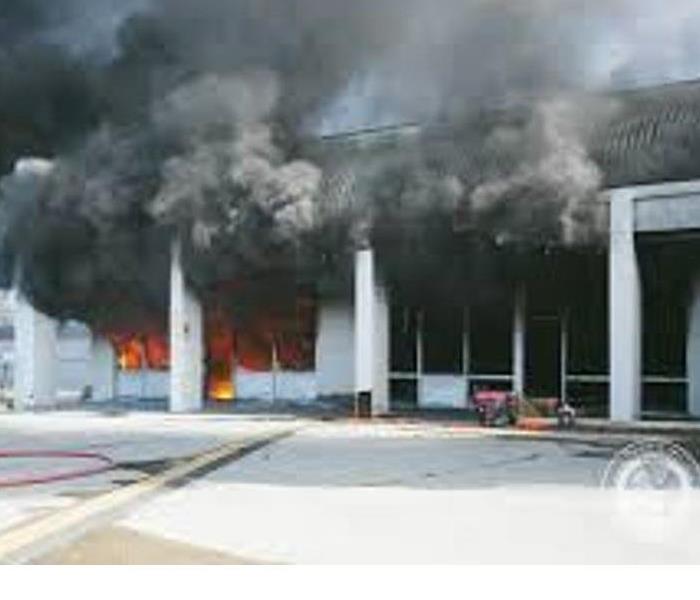 Fire can have a severe impact on your commercial business
Fire can have a severe impact on your commercial business
Fire damage is a common and dangerous disaster regardless of whether it is a commercial or residential property. Considering all the elements, fire in a commercial property like an office space can have a bigger impact than most, especially when taking into account the lives and careers of the employees in addition to the trading, which often comes to a standstill.
There are several critical impacts of fire on commercial property, which, if foreseen, can make a big difference when it comes to the smooth and productive functioning of your business.
Business incapacitation
The most observed effect of fire to a business is the damage and destruction of the property itself. As most businesses are self-contained, the business as usual, or the operational procedures ceases. This drains the potential of the business to be productive and reliable.
Moreover, the downtime is always exponential to the revenue loss. For every day, the business remains offline, the average revenue takes a fall, which in turn starts affecting the employees and other stakeholders. Any business that suffers such loss might take weeks or months to recover.
Data loss
Most large businesses have a centralized data storage structure to store all their data. However, small or medium businesses are usually vulnerable to data loss, when considering a potential fire threat. The data loss might be in the form of both digitally stored data and physical file formats.
Even a minor data loss like a small portion of a big project, it will still require the concerned stakeholders to perform research, spent time, and carry out several collaborations to put all the pieces back in place.
Loss of inventory
Depending on the type and size of the business, they might house some onsite inventory goods or products. A fire can inflict mass damage and destruction to these goods. These goods or products might be in the form of something that needs to be delivered or used within the business. Even though you have insurance coverage, you might end up paying an additional amount for replacing these products.
Impact on staff
The effect of office fires on employees is often overlooked when considering how devastating it can be for the business physical structure, products, and overall revenue. Employees risk lost wages and involuntary unpaid leaves.
Suffering any injury during a fire makes things further complicated and worse for them as they have to deal with some away time and hefty medical bills.
Furthermore, the severity of fir damage impact can force the business to make some drastic changes to the business structure after a considerable amount of time like making people redundant. This is usually done when the business finds it difficult to make up for the loss suffered due to fire.
Once affected by a fire, opening the doors and restoring the business as usual procedures are the priority of any business. This is where a SERVPRO of Streamwood, Bartlett, West Chicago, & Warrenville with some additional services like insurance documentation assistance can play a crucial role.
Fire Protection in Strip Malls
10/5/2020 (Permalink)
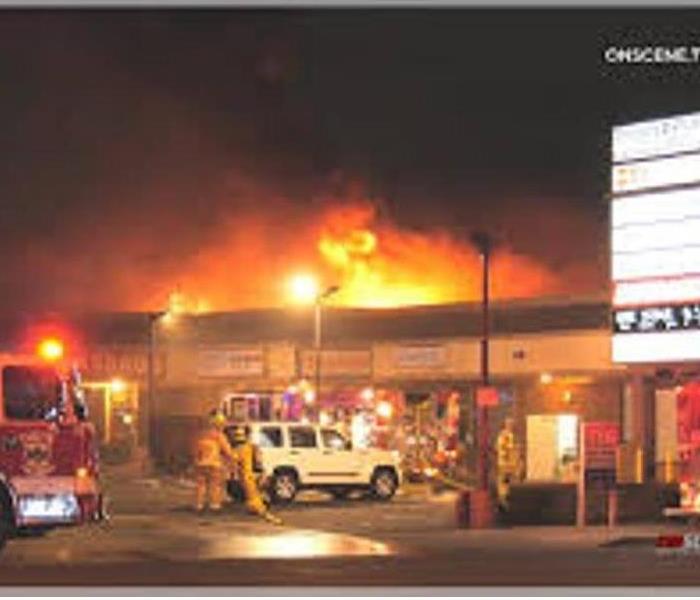 Fire Safety for Strip mall businesses
Fire Safety for Strip mall businesses
Shopping centers are responsible for fire protection; however, there are certain boundaries and handling of the responsibilities that every shop owner or tenant must be aware of. For instance, if you enter the confines of an individual shop in a shopping mall, fire protection is the responsibility of the shop owner.
As a shop owner, you can expect such scenarios and policies penciled down on your lease agreement, so ensure to double-check the pertinent conditions before you put pen on paper. This post will feature some common things to be considered while ensuring fire protection in shopping centers.
Fire extinguisher maintenance
Fire extinguishers can vary from size to type. For instance, you have water, foam, powder, and Co2 fire extinguishers. You need to talk to a specialist when choosing the right one for your retail shop as your selection should be based on the type of store, the storage commodity, and more.
Service fire extinguishers on a regular basis and consider it mandatory to have them serviced annually to ensure that they are in compliance.
Fire alarm maintenance
Even though the shopping centers will have centrally controlled fire alarm systems, you are responsible for the ones that are within the confines of your shop.
Service and test these fire alarms as per your council’s requirements and ensure that you have the respective logbooks updated.
Fire signage
A fire and evacuation diagram can turn out to be a lifesaver. This together with other fire safety signage can be critical when the unexpected happens. Position the signage ideally to map out the escape routes for your customers, who might not have any idea about the compound layout in case of emergencies.
An ideal means to ensure that everything looks good is by checking whether you can see a fire exit sign wherever you are within your shop.
Emergency lighting
Emergency lighting is another important fire safety measure that should meet compliance. A fire breakout can easily sabotage the lighting circuits. As precautionary measures, the fire safety officers tend to disconnect the electric supply to any property under fire. Foresee such scenarios and ensure that you have proper and efficient lighting within your property which can guide yourself and the emergency service team.
Fire training
Fire training should be mandatory for staff in your outlet. Train yourself or at least one staff within your establishment about evacuation procedures and setups within the shop. Electing a fire warden can help you to alleviate stress and chaos in case of any emergencies.
Moreover, consider engaging in some fire mock drills to ensure that everything goes as planned in case of emergencies. You might be surprised to learn that most people are unaware of how to use a fire extinguisher in case of emergencies. Even with clear instructions marked on the product itself, the stress and the chaos that the situation creates can make it difficult for your function normally. This is where mock drills can come in handy.
Ensuring fire safety within your shop can be challenging and requires careful planning and thought processes.
HOW TO DISINFECT YOUR WORK ENVIRONMENT
9/23/2020 (Permalink)
 Be safe at work. Disinfect your work area
Be safe at work. Disinfect your work area
We all have to do our part to stay healthy, safe, and protect each other right now, so keeping your work environment clean is more important than ever. SERVPRO of Streamwood, Bartlett, West Chicago, & Warrenville has been working around the clock to protect businesses, homes, and people for over 10 years. Here are a few tips for keeping the work environment clean, disinfected, and what to do if someone is sick.
How to Clean Your Workspace
In addition to practicing respiratory etiquette and good hand hygiene, you can slow the spread of germs by simply cleaning your area regularly. Most workplaces have regular facility cleaning procedures conducted by a professional team. Cleaning refers to the physical removal of grime, dirt, and debris from surfaces using soap and water. High-touch surfaces like desks, keyboards, phones, door handles, elevator buttons, and light switches need to be cleaned regularly as part of a facility cleaning protocol.
Simply using a general household cleaner according to its instructions is all you need to effectively clean the area. Wipe down your desk, office items, chair armrests, and your immediate area until they are visibly clean. This prepares the area for effective disinfection.
In addition to daily cleaning, any surface that is visibly soiled needs to be cleaned immediately. It’s a good idea to wear gloves while cleaning to avoid coming into contact with the dirt. While cleaning doesn’t necessarily kill bacteria and viruses, it removes them to lower the number of microorganisms on the surface.
When to Disinfect the Workplace
Disinfecting is a method of removing bacteria and viruses by killing them with chemicals. To perform proper disinfection, clean the area to be disinfected with a general cleaner, then use an appropriate disinfecting product. The Environmental Protection Agency (EPA) has a list of registered disinfectants, but bleach or a cleaner with at least 70% alcohol will work if other products are not available.
There are no set rules about disinfecting the work environment, but it’s recommended to disinfect frequently used items in a public space, like a refrigerator door handle or break room light switches, after each use. Your own individual work area should be disinfected every day if you are the only one using it, but more often if multiple people are working in the area.
MINIMIZING BUSINESS INTERRUPTION
9/23/2020 (Permalink)
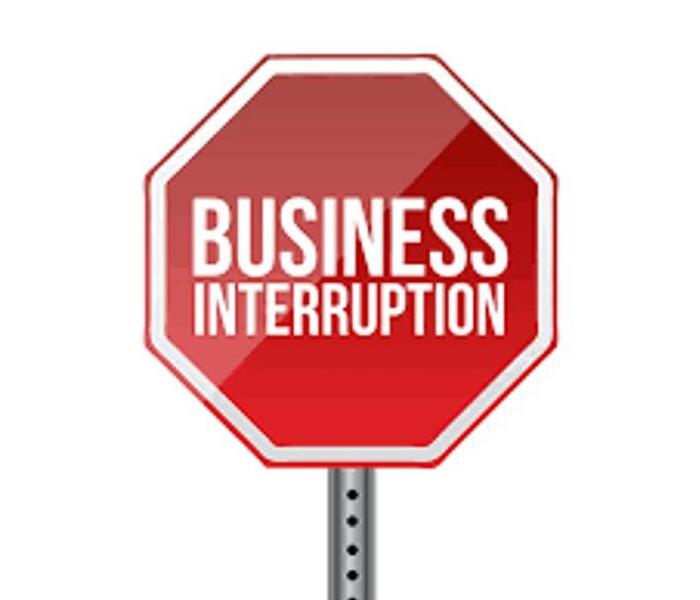 Minimize business interruption by being prepared
Minimize business interruption by being prepared
No one is immune to natural disasters, property damage, or business disruption. With SERVPRO of Streamwood, Bartlett, West Chicago, & Warrenville, you can feel confident that you have a partner in the restoration process bringing decades of experience and professionalism. Combined with our business continuity and disaster loss planning services and commercial restoration experience, we are here to help you plan for the unthinkable and mitigate losses.
Create a Business Continuity Plan
It’s impossible to predict the future, but there are ways to ensure you have a plan for any interruptions in your business. Almost half of all small businesses are permanently shuttered after a disaster, and knowing what to do ahead of time can make the difference in whether you’re able to get back up.
Continuity plans aren’t just for massive property damage caused by a natural disaster. A roof leak or mold problem requiring repair and clean-up can displace employees for days or even weeks.
Some key benefits of a continuity plan include:
- Minimizes financial losses
- Reduces operational down-time
- Identifies opportunities for employees to continue working
- Expediting the restoration process
If Disaster Strikes, Act Quickly
Minimizing business impact starts with a plan. In addition, to quickly enacting the plan when a loss occurs, it’s also important that your workforce is aware of it and knows what to do. Ensure policies and procedures are in place based on the continuity plan and train the workforce regularly. Communication is key!
In addition to notifying employees, you must also act quickly to minimize physical damage. Once the area is safe, work to preserve critical equipment and files. Remember that a scene that looks disastrous may not be as bad as you think, especially with professional restoration services.
How To Prevent Clogging Of Drains in Commercial Kitchens
9/22/2020 (Permalink)
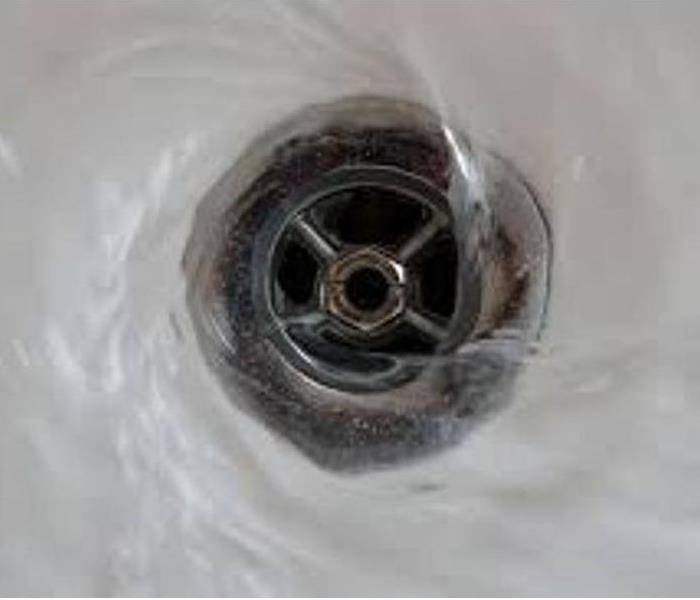 Prevent clogging drains before they become a problem for your commercial kitchens
Prevent clogging drains before they become a problem for your commercial kitchens
The drains are a significant part of the plumbing system and they are exposed to water in routine. The regular usage of sinks, washbasins, dishwashers, bathrooms, etc. leads to the flow of a large amount of dirt, debris, and other material into the drain pipes which may cause clogging of the drains. The situation can get worse than you can imagine when the blocked drain pipe obstructs the flow of water and it starts to move in the backward motion. This can damage your drainpipe, pipe joints, and maybe the hardware.
Disposing of garbage: first of all, all the garbage must be disposed of properly. Either you have a particular location to get your garbage or you can have a garbage can at all the possible areas where the garbage could flow into the pipes causing clogging. Sometimes the vegetables and the other eating stuff could get into the drains causing blockage but if you have a garbage can around you, you can easily manage to separate the water into drains and the vegetables like stuff into the garbage can or trash bins.
Grease and oils: grease and oils are very common in the kitchen. Your dinner dishes which were served with chicken full of gravy may get difficult for you to remove from the dishes and hence the water containing oil and grease flow through the pipes increasing chances of clogging. You can put the leftover food into the disposable bags to avoid grease and oil clogging inside the pipes.
Drain screens: the next step which can be very beneficial to your kitchen and bathroom cleaning habits is to have drain screens or stoppers that could prevent the flow of debris or other stuff into the drain pipes. You can easily clean that kind of stuff by using a stopper and then you can release the water by plugging out the stopper.
Use boiling water: it is very familiar to all the women who work on their own in the kitchen for preparing food and cleaning dishes. Using boiling water once in a week or 10 days could avoid the deposition of oils and grease matter into the pipes that can cause clogging.
Hardware care: for making sure that all the pipes are working fine to drain the water and other liquids, you must ensure that the hardware must be in good condition such as pipes. Pipe fittings, tap, stopper, etc. suppose you have a damaged bend inside the drainage system, then the chances of blocking the dirty water flow outside the building reduce causing you trouble to deal with stinky smells and the clogged water that could only be worked by some professional plumbing service.
Water Damage Prevention Tips For Commercial Buildings
9/10/2020 (Permalink)
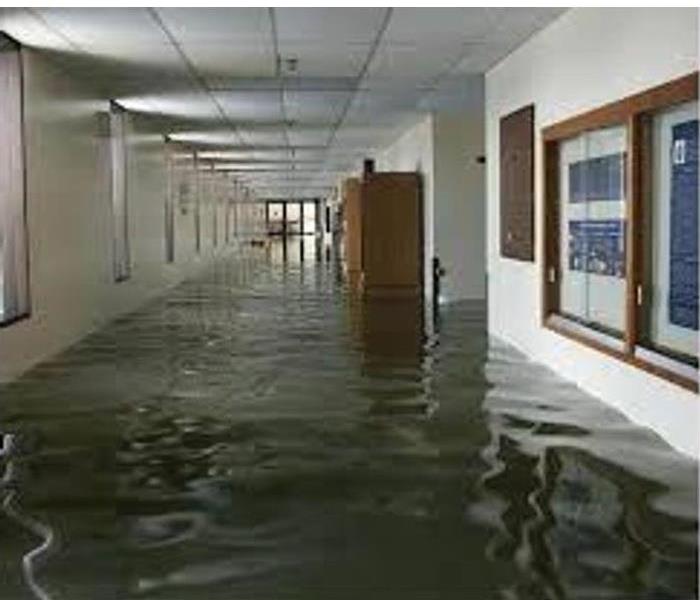 Know how to protect your commercial property from water damage
Know how to protect your commercial property from water damage
Water damage in commercial buildings can be a huge problem for a number of reasons. Beyond the damage from an actual flood, it can also put the health and wellbeing of your employees in jeopardy, and, depending on the industry, force you to shut down business for a while. Just adhering to the four simple tips listed below from our restoration experts at SERVPRO of Streamwood, Bartlett, West Chicago & Warrenville will significantly decrease the likelihood of a disaster in your commercial property.
Install A Flood Monitoring System
An increasingly popular option for business owners is installing flood monitoring systems. Flood monitoring devices are one of the most effective ways to mitigate water damage in commercial properties. Flood monitoring systems work by sensing the water levels in the property. If the water level rises above a certain point, the system will immediately send you an alarm that a flood is ongoing. This is extremely valuable because the worst floods are those that go undetected for a long period of time. With a flood monitoring system, you will be notified immediately so you don’t have to worry about your property filling with flood water overnight or over the weekend.
Inspect The Property For Water Damage Regularly
One of the best ways to prevent water damage is to look for signs of water damage in its infancy. Water damage takes time to develop into a major issue so if you put a stop to a leak as soon as it starts or removes the source of mold problem while the mold growth is still minor you should be able to avoid any major water damage issues.
Invest In Facility Maintenance
A preventative maintenance plan should help keep your commercial building safe and secure and contribute to your water leak prevention efforts. Different parts of a commercial building should be inspected at different intervals. For example, doors, windows, and gates should be checked each year for weariness while the roof can be coated every five years or so to prevent damage.
Get Good Insurance Coverage For The Property
No matter the size and severity of a water damage event in your commercial property, you will need quality insurance coverage to cover the costs of the cleanup and restoration. You may also want to include flood damage insurance in your policy since most water damage insurance policies don’t actually cover damage caused by a flood.
In a perfect world, these tips will help you avoid any water damage events from ever occurring in your commercial property. In the event of a mistake or freak accident that leads to a flood, however, you should be prepared to call for professional help without delay.
Commercial Water Loss
6/7/2018 (Permalink)
The weather has been very unpredictable the past few weeks in our area. We have experience heavy rains in a short period of time causing the sewer systems to back up and streets to flood.
If you see there is a flash flood watch, this means that a flash flood is possible. A flash flood warning means that a flood is about to happen or already taking place. If a flash flood occurs, you should make sure everyone gets to higher ground as quickly as possible.
Your business can prepare for any potential disaster, including flash floods. Keep all essential equipment and documents elevated from the floor. Ideally, they should be stored on the second floor of the building or higher. Back-up electronic data daily to cloud storage or to an external drive so the files can still be accessed in the event of a disaster.
It is a good idea to have a battery-powered radio available on-site or even some sand bags to help with water absorption. In case of a power outage, you and your staff can keep updated on the current conditions. (FEMA) The Federal Emergency Management Agency provides a list of recommended sites in the event of a disaster, such as a flashlight and first aid kit.
You can also check with the National Weather Service to get more tips on safety during flooding.
SERVPRO of Streamwood/ Bartlett/ West Chicago City can help your business get back on track after flooding or other disasters. Call us today for more information or a free inspection 630-562-9212
Commercial Restoration
5/31/2018 (Permalink)
Large Loss Response Team and Disaster Recovery Teams are SERVPRO's elite franchises placed throughout the country to respond Faster to Any Sized Disaster.
The best way to reduce business interruption following a disaster is to plan for it NOW.
As many as 50% of businesses may never recover following a disaster, according to the latest industry research. Of the businesses that survive, the overwhelming majority of them had a preparedness plan in place. Pre-planning can serve as an insurance policy aimed at peace of mind.
By developing a SERVPRO® Emergency READY Profile for your business, you minimize business interruption by having an immediate plan of action. Knowing what to do and what to expect in advance is the key to timely mitigation and can help minimize how water and fire damage can affect your business.
Are You Ready?
Preparation is a key component for making it through any size disaster, whether it’s a small water leak, a large fire or an area flood. The best time for planning for such events is not when the event happens, but well before it happens. No one ever plans on a disaster, but you can plan for it. Now is the time to ask yourself, “Are you ready for whatever could happen?”
The SERVPRO® Emergency READY Profile is a startup approach that provides the critical information needed to begin mitigation and recovery services. It is designed to serve as a quick reference of important building and contact information. By working with SERVPRO’s Emergency READY Profile, your business will receive the benefit of over 40 years of experience in reducing the impact of any natural or man-made disaster.
SERVPRO® is a leader in water and fire damage response and can help you quickly get your property back in working order.
The SERVPRO® Emergency READY Profile is a no cost assessment of your facility. It provides:
- A concise Profile Document that contains only the critical information needed in the event of an emergency - a guide to help you get back into your building following a disaster.
- Identification of the line of command for authorizing work to begin. This saves time so we can begin the work of mitigating the damage which can save you time and money.
- Facility details such as shut-off valve locations, priority areas and priority contact information. Having a quick reference of what to do, how to do it and who to call provides solutions in advance of an emergency so that during the emergency you are “Ready for whatever happens.”
At SERVPRO of Streamwood/ Bartlett/ West Chicago City - we are committed to partnering with our commercial clients to reduce business interruption in the event of any type of disaster.
Call us at 630-562-9212 to get started - it costs you nothing to make the call. Not making that call may be VERY costly.
Water Mitigation in Commercial Buildings
5/31/2018 (Permalink)
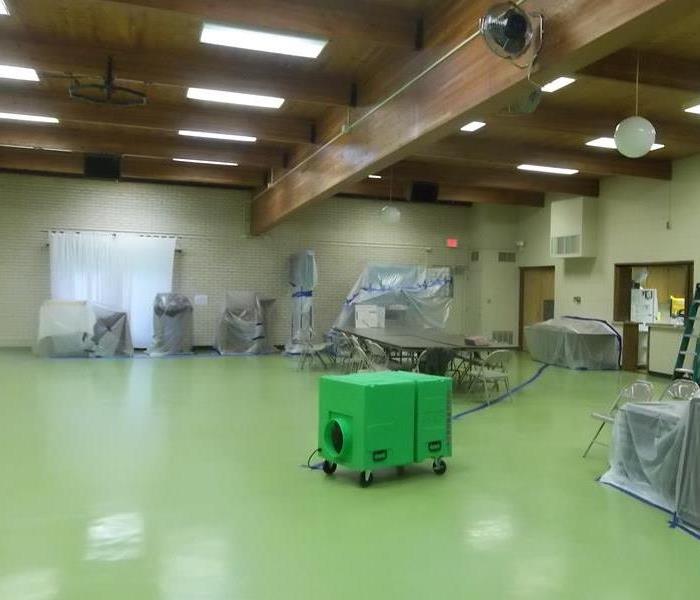
Many business owners forget that storms and severe weather aren't the only causes of floods and water damage. Here are some of the common causes of water damage to commercial buildings.
1. Malfunctioning sprinkler systems.
Some older office and retail buildings still have outdated sprinkler systems that work in conjunction with fire protection systems. While such sprinklers can come in handy during a fire emergency, they can also cause commercial flood damage if they are faulty or in need of replacement. This could easily damage inventory and business assets.
2. Damaged appliances and equipment.
This cause of commercial flood damage is more common in restaurants and catering facilities, as well as any business that have appliances and equipment that make use of water. If the appliance fails and sends water across your building, especially during late hours when no one is around, you may come back to work and face a water emergency.
3. Broken pipes and plumbing.
Just like in a residence, if the plumbing system in your workplace fails water damage could be the result.
4. Backed up sewer lines.
This is another cause of commercial water damage that often catches business owners by surprise. Should the sewer line to your building back up or become damaged, the potential dangers of contaminated Black Water which can cause health effects and ruin products and office furnishings.
Call SERVPRO of Streamwood/ Bartlett/ West Chicago City today. 630-562-9212
Commercial Loss Specialties
5/31/2018 (Permalink)
Commercial Property owners and Property Managers are entrusted with keeping their businesses operational. When Disaster Strikes, SERVPRO of Streamwood/ Bartlett/ West Chicago City is here to help make it “Like it never even happened.” Facilities Managers rely on us to be ready for Whatever Happens.
General Adjusters and Consulting firms from around the Chicago land area trust SERVPRO of Streamwood/ Bartlett/ West Chicago City with their most complex claims. Some of our specialties include:
- Small Office Buildings
- Large Office/High-Rise Office Buildings
- Apartment Buildings
- Restaurants
- Hotel/Motels
- Commercial Reconstruction
- Small Retail Stores
- Large Retail/Big-Box Stores
- High-Rise Residential
- Manufacturing & Industrial
- Government/Military
- Universities
- Schools
- Restaurants
- Commercial Disaster Recovery Services
- We are available around the clock to get your business back up and running. Our expertise includes restoration services for fire and water damage, including electronics restoration and document drying.
Learn more about our commercial restoration services by calling SERVPRO of Streamwood/ Bartlett/ West Chicago City at 630-562-9212
Commercial Loss Experts
5/30/2018 (Permalink)
Whether your business is a small retail store or a multi-building campus of buildings, SERVPRO of Streamwood/ Bartlett/ West Chicago City has the expertise and the equipment to handle any fire, water, or mold emergency.
Commercial Water Damage
Water damage can happen in many ways. A frozen pipe in a warehouse could burst and cause extensive damage. A burst pipe or a leaking roof in a manufacturing plant can shut down the production line causing huge losses. In apartment complexes, there could be an overflowing bathtub or toilet that causes damage in the complex. When any of these events happens, it’s important to call water damage professionals immediately in order to alleviate the damage. When hiring a water damage cleanup company, it’s important to make sure they have the expertise and equipment to such a large job.
Commercial Fire Damage
Even the smallest of fires can result in extensive damage to a building. While the fire itself can be isolated and extinguished quickly, the culprit of most damage after a fire is the smoke. Smoke can get into the duct work and quickly spread throughout the building. With fire and smoke damage, it’s important to hire fire restoration professionals that can quickly restore your business, your warehouse, your facility, or your residential complex.
Commercial Mold Remediation
Mold is the result of a moisture problem that has usually been neglected. This can be the result of a leaky pipe that is hidden behind a wall or in a ceiling. Mold can also grow quickly when there has been water damage from the contaminated water like a broken sewer pipe or flooding from a nearby river or stream. Contaminated water, also known as gray water or black water, can quickly promote mold growth in less than 24 hours. If not treated, it can quickly grow and cause not only property damage but potential health risks among inhabitants.
Commercial Storm Damage Cleanup
Storms can cause all types of damage to a building. They can cause flooding from rising rivers. They cause water leaks from damaged roofs. They can cause fires from lightning strikes. Tornadoes and high winds can break windows, tear down walls, rip off roofs, and in the worst cases they can level the entire building. A professional fire and water restoration company has the equipment, experience, and knowledge to handle any type of storm damage.
Damage to a business can come in many forms. From fire to water damage to storm damage and everything in between, SERVPRO of Streamwood/ Bartlett/ West Chicago City has the experience, equipment, and expertise to make it like it never happened. Whether you have a small store or a multi-building complex, call the commercial restoration, remediation, and cleaning experts at SERVPRO of Streamwood/ Bartlett/ West Chicago City at 630-562-9212.





 24/7 Emergency Service
24/7 Emergency Service
